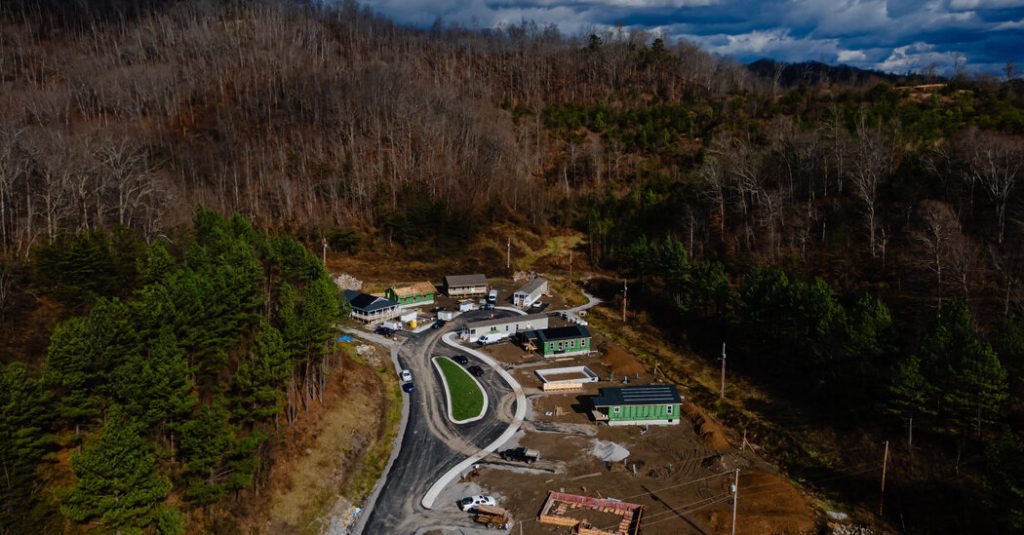For all the trouble it has caused, River Caney is an unassuming creek.
The rustling strip of water meanders slowly, less than a foot deep in some parts, along a sandy bank behind a few dozen homes that occupy a narrow hollow in eastern Kentucky.
But in 2022, a horrific flood tore through this quiet lane of green land, framed on either side by the Appalachian Mountains, killing 45.
Sherry Mullins watched her double-wide trailer tip toward raging floodwaters before she and her neighbors were rescued by helicopter. Much of the land that had been in her family since the 1700s was eaten away by toxic, mud-soaked water. She can never build in the floodplain again, but she still owns a patch of lawn where her house once stood.
“I don’t care if there’s six inches left,” Mullins told me. “We won’t sell it.”
As I reported in an article published today, Mullins is one of many flood survivors that have relocated to new communities built on former coal strip mines that top the mountains surrounding her old hollow.
From her kitchen window in the Blue Sky neighborhood, she can watch the construction of new houses where her old neighbors have also chosen to relocate. Others have chosen to stay.
What happens to your community if it’s been upended by the kind of extreme weather that’s becoming increasingly common under climate change?
That’s a question that River Caney residents have been facing since the flood and that tens of thousands residents in Los Angeles have been struggling with since fires destroyed whole neighborhoods this month.
Since I began reporting on floods affecting my home state of Kentucky in 2021, there’s been a tension in the region between escaping the floodplain and honoring generational ties to the land. As communities across the country are being altered by extreme weather and climate change, financial resources, familial bonds and trauma often shape the decision of whether to stay or leave.
New climate migrant communities
Seven high-ground communities under construction by the state of Kentucky embody the complicated relationships between frontline communities and extractive industries. (Blue Sky, where Mullins lives, predates the 2022 disaster.)
Eastern Kentucky’s connection to the coal industry has always been one of give and take. Almost every family I met during my visit had at least one member who’d worked for a coal company, from miners to mechanics to security guards. These well-respected jobs could earn upward of $80,000.
But coal jobs have dwindled, creating a gaping hole in the region’s economy and making it difficult to keep schools, infrastructure and local government running.
The burning of fossil fuels, like coal, is the primary cause of climate change, which causes more intense and frequent rainfall and floods.
Down the street from Mullins, folks she’s known all her life, like her neighbor, Farmer Baker, and her niece, Heather Robertson, are buying new houses above the floodplain.
Baker lost his wife, Vanessa, as they were escaping their home during the flood. Robertson lost her sister, Amy Henson, who was rescuing her horse from a barn in the backyard.
Robertson, 38, said she was heartbroken to leave River Caney, the only place she’s ever lived. Her home wasn’t damaged in the flood, but she said she wanted a more secure future for her kids, ages 9, 5 and 2. “I wanted to get my children out of the flood zone,” she said.
Staying in a disaster zone
But even with the risks, not everyone can afford to leave the floodplain, and not everyone wants to. Since the flood, about three-quarters of the community has stayed, but the population has dwindled from relocation and death, Mullins, and her aunt, Deborah White, told me.
White lives next to Mullins’s former home on River Caney. In late December, she stood on her front lawn in an old sweatshirt while her dog, a flood rescue named Liberty, ran at her feet.
These hollows are stitched together by families who have often invested in their land and their homes for generations. White has tried to keep the tradition of close family ties alive by hosting weekly Sunday dinners where dozens, including Mullins, crowd into her modest blue home that’s often heated with coal. But even with a regular flow of visitors, she’s struggled with her mental health.
“I don’t care how much therapy you get, it’s still in the back of your mind,” White said of the flood. Overhead, clouds gathered as we spoke.
Rain, then hail, began to fall. “It may never leave us,” she said.
Even for people like Baker who chose to leave River Caney, they remain bound to what they left behind.
Down the road, I stopped by a memorial that Baker built for his wife: a wooden pergola adorned with wind chimes and statues of angels erected where his house used to stand. He spent the insurance money from the 2022 flood to buy an excavator, truck and trailer that he uses to search for her body. She’s the only victim from the flood who’s never been found.
“I said I’d never leave River Caney until this happened,” Baker told me from his living room higher up the mountain in Blue Sky, a photo of his wife resting on his knee.
“Now I don’t want to live there. Because I know it’s going to happen again.”
A $400 million boost for fusion
As A.I. and data centers drive up electricity demand, investors are making big bets on a long-sought, and still unproven, source of emissions-free power.
Helion Energy, a fusion start-up in Washington State, on Tuesday said it raised $425 million in its latest round of funding, bringing the total amount invested in the company to more than $1 billion. The investors in the latest round included existing backers such as Sam Altman, the chief executive of OpenAI, plus new ones like SoftBank, the Japanese conglomerate, and the venture capital firm Lightspeed Venture Partners.
In recent years, private investors have pumped capital into a raft of start-ups that are working to bring fusion, the process that powers the sun, out of the lab and onto the grid. Scientists say these projects still have formidable hurdles to overcome, as I explored in The Times last year.
Yet Helion is promising results soon: The company has an agreement to start generating electricity for Microsoft in 2028. Several other well-funded start-ups, including Commonwealth Fusion Systems in Massachusetts, are targeting the 2030s. When asked what the latest funding round represented for Helion, the company’s chief executive, David Kirtley, said: “It’s pressure to go even faster.” — Raymond Zhong








